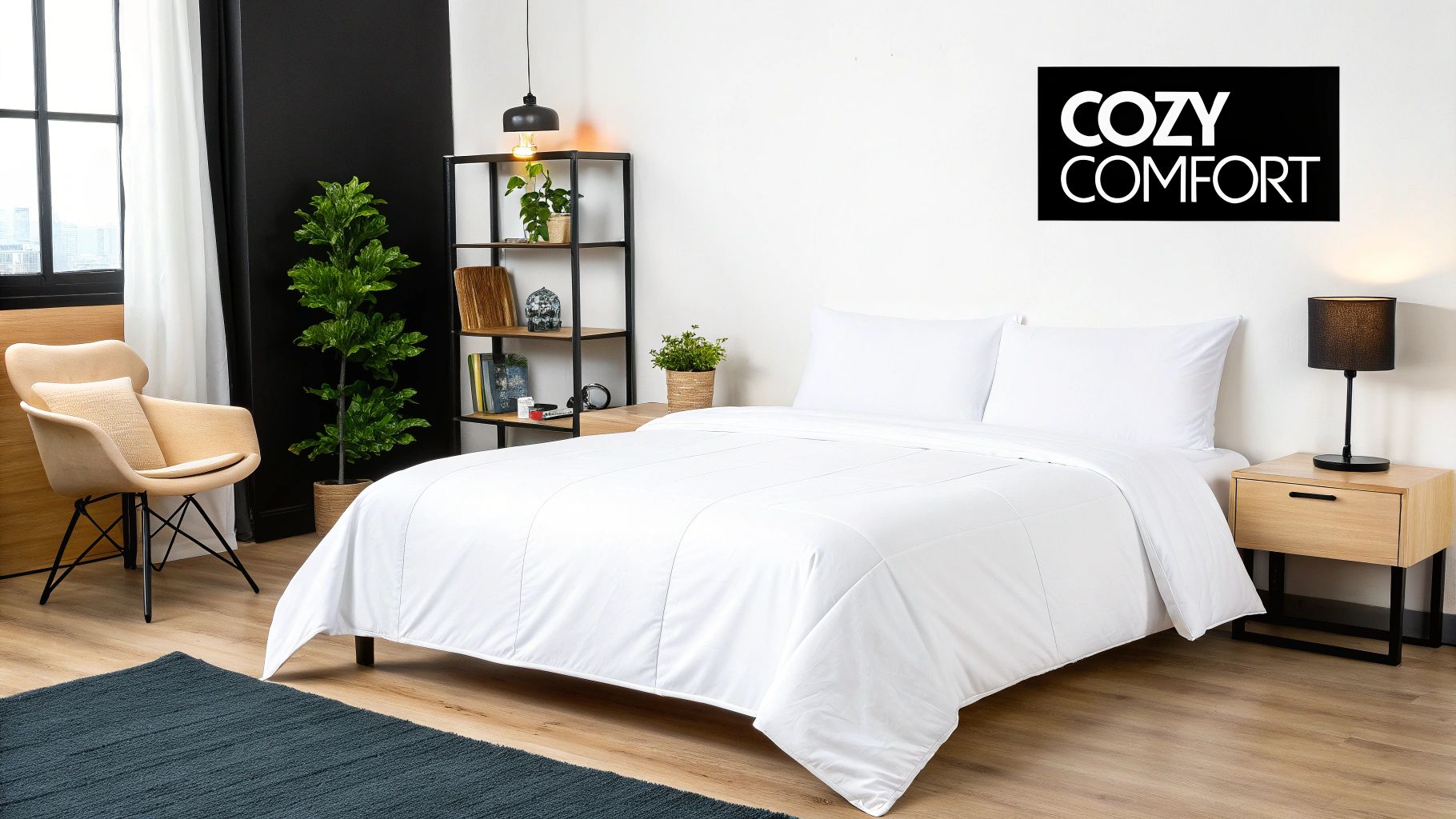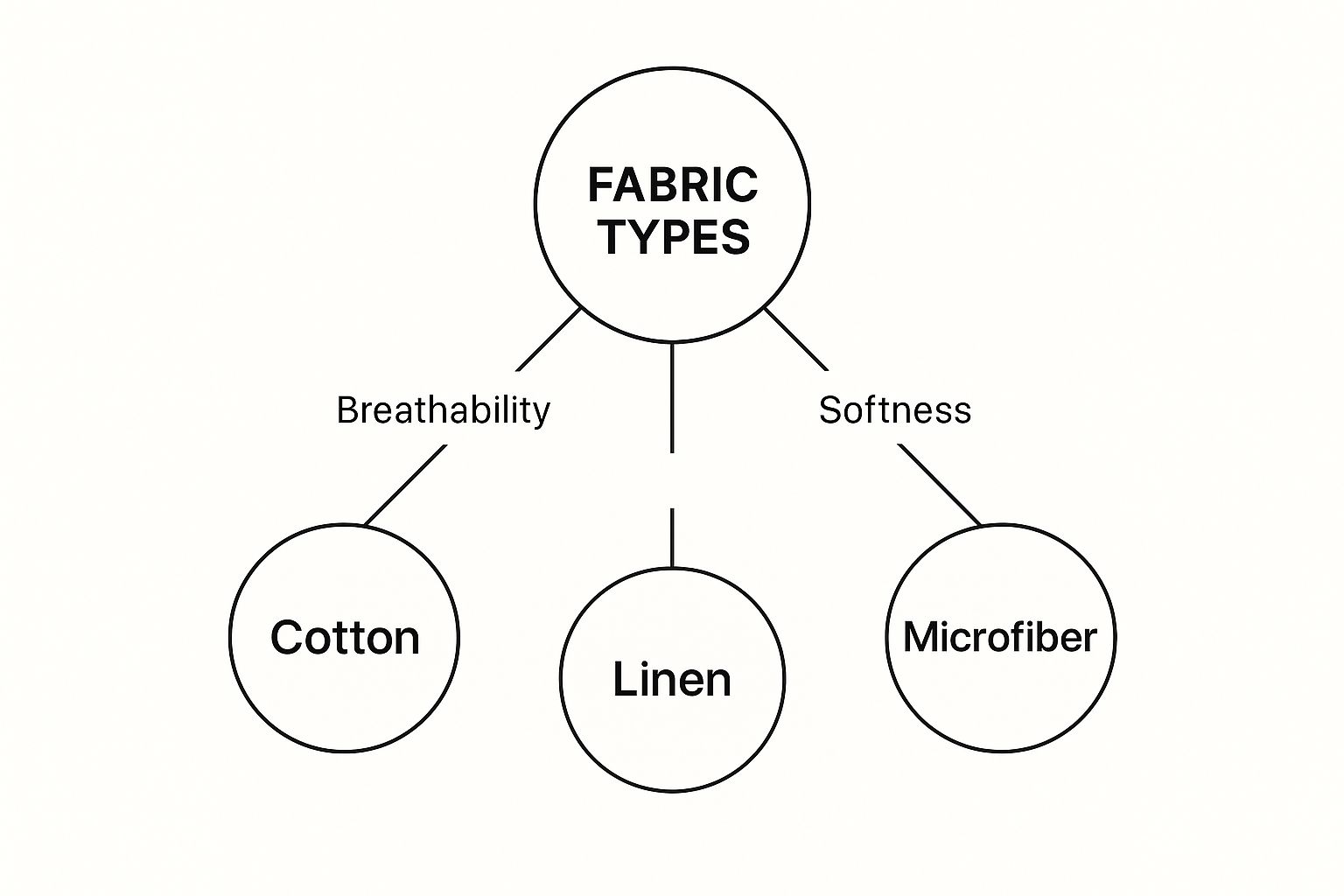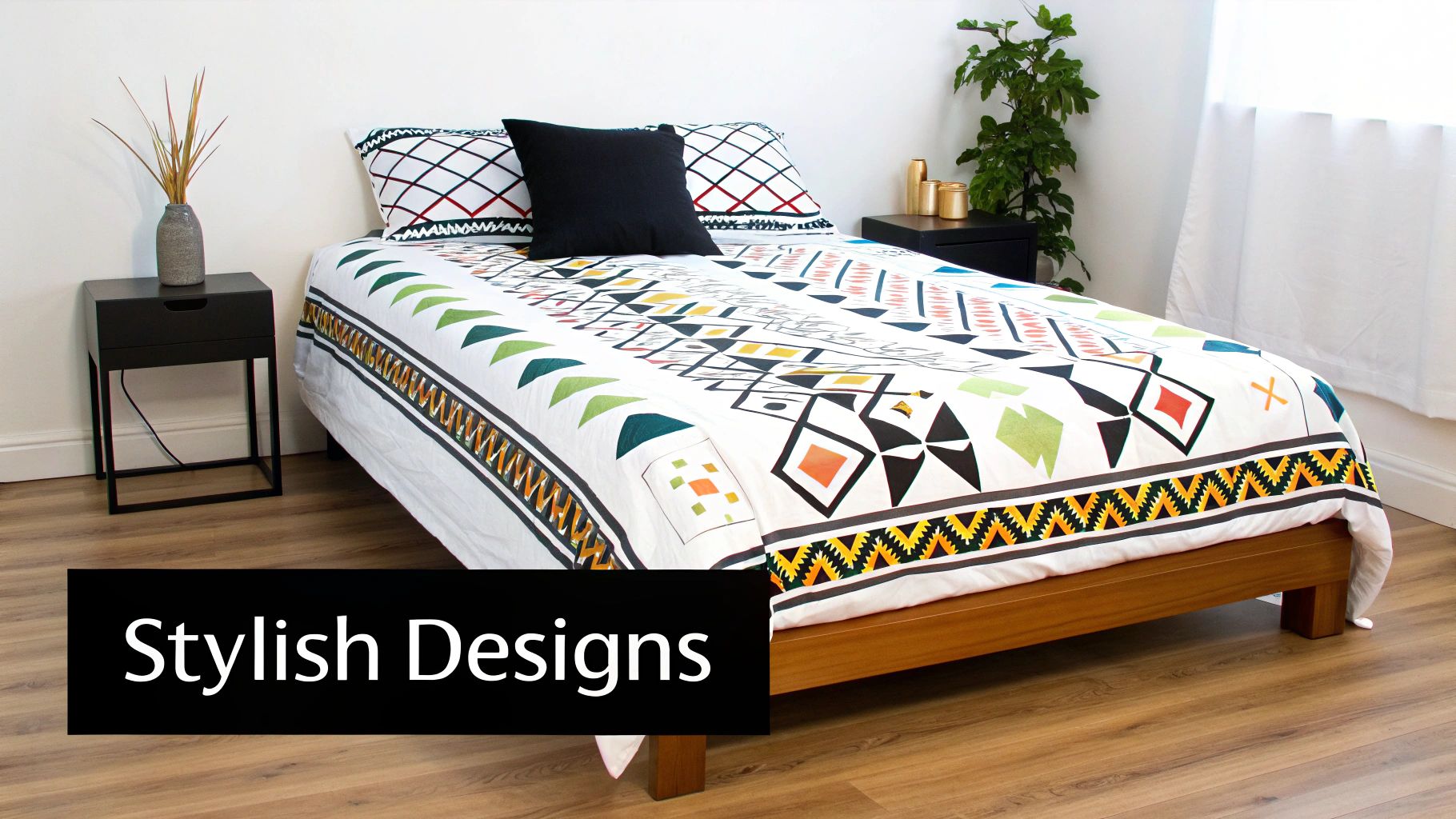Your single duvet cover is so much more than just another piece of bedding—it's the real centrepiece of your personal retreat. It has the power to set the entire mood for your room and plays a massive part in how comfortable you are and how well you sleep.
Your Guide to a Better Bedroom Sanctuary

Think of your bedroom as a genuine escape from the hustle and bustle of the outside world. In this space, your single duvet cover is the main canvas, influencing everything from the room's overall feel to the quality of your rest. This guide is here to be your complete roadmap, helping you navigate all the choices out there and cut through the confusing labels and generic advice.
We’re going to break down everything you need to know in a simple, practical way. The goal is to leave you feeling confident enough to pick a duvet cover that doesn't just look stunning but also feels absolutely perfect against your skin.
Why Your Duvet Cover Matters
Getting your bedding right is one of the most important steps in turning your bedroom into a space you truly love. A fantastic single duvet cover does more than just protect your duvet; it elevates your entire sleep experience.
- Defines Your Style: As the most dominant visual on your bed, it’s a quick and easy way to show off your personal aesthetic, whether that’s clean and minimalist, bold and eclectic, or timelessly classic.
- Impacts Sleep Quality: The fabric makes all the difference. A breathable material like linen is brilliant for regulating your temperature through the night, while a silky-smooth sateen can add that little touch of everyday luxury.
- Sets the Room’s Mood: The colour and texture you choose can make a room feel wonderfully calm and serene or vibrant and energetic, completely changing its atmosphere.
A thoughtfully chosen duvet cover is an investment in both your home's style and your personal wellbeing. It bridges the gap between the practical need for comfort and the desire for a beautiful, restful environment.
This guide will walk you through the subtle but important differences in materials and the art of styling. If you want to dive even deeper into this idea, our article on creating a bedroom sanctuary has even more tips for crafting a truly peaceful space.
By the time you're done here, you’ll know exactly how to turn your bed into the cosy, stylish retreat you deserve.
Decoding Duvet Cover Materials and Weaves
Choosing the right material for your single duvet cover is easily the biggest decision you’ll make. It’s what directly dictates how your bed feels and, ultimately, how well you sleep. Getting your head around the world of fabrics might seem a bit much, but understanding the key differences is simpler than you’d think.
Forget the confusing jargon. It's really all about how each material feels and performs in the real world. Think of it as the heart and soul of your bedding. A chef picks specific ingredients to create a certain taste and texture, and in the same way, you'll choose a fabric for its unique comfort.
The Foundation of Comfort: Popular Materials
The fibre itself is the absolute building block of comfort. While there are plenty of new blends out there, a few trusted classics remain popular for very good reasons. Each one brings something special to the bed.
- Cotton: The undisputed champion of bedding. Cotton is loved for its breathability, natural softness, and durability. It’s a wonderfully versatile fibre that can be woven into everything from crisp percale to silky-smooth sateen.
- Linen: Made from the flax plant, linen is one of the oldest and most treasured textiles on earth. It's incredibly strong, absorbent, and famous for its unique ability to keep you cool in summer and cosy in winter.
- Bamboo: A bit of a newcomer, but bamboo fabric (usually a type of viscose) is praised for its incredible softness and moisture-wicking properties. It's a fantastic choice if you tend to sleep warm.
This preference for natural fibres isn't just a local trend; it's a global shift towards quality and sustainability. The worldwide duvet market is expected to hit US$2.64 billion by 2032, with natural materials making up a huge 62% of that. This tells us that Kiwis, who have a real appreciation for natural products, are right on trend. For a deeper dive, you can check out the full duvet market research.

As you can see, each material shines in a different way. Cotton is a master of breathability, linen delivers exceptional softness, and microfibre offers great durability. It's all about matching the material to what matters most to you.
Weave: The Secret to Texture and Feel
Once you’ve settled on a material, the next thing to consider is the weave. The weave is simply how the threads are interlaced, and it completely changes the fabric's final texture, look, and performance. Two of the most popular weaves you’ll find for a luxury single duvet cover are percale and sateen.
Think of it like two artists using the exact same paints but different brushstrokes. One creates a sharp, detailed image, while the other produces a soft, blended masterpiece. The weave does the same thing for fabric.
Percale: This is a classic, one-thread-over, one-thread-under grid-like weave. The result? A crisp, cool, and matte finish that feels wonderfully light and airy—just like the high-end hotel bedding so many of us love. It’s incredibly breathable, making it perfect for summer or for anyone who sleeps hot.
Sateen: This weave is a bit more complex, typically one-thread-under and three or four threads-over. This technique exposes more of the thread’s surface, creating a fabric with a silky-smooth feel, a subtle sheen, and a beautiful drape. Sateen feels a little heavier and warmer, giving you a real sense of luxurious cosiness.
Neither weave is better than the other; it’s purely down to personal taste. Do you love that crisp, cool feeling of a hotel bed, or do you prefer the silky, sumptuous feel of luxury sheets? Your answer will point you to the perfect weave.
To make things even clearer, here's a quick comparison of the most common materials you'll come across.
Single Duvet Cover Material Comparison
| Material | Feel & Texture | Best For | Care Level |
|---|---|---|---|
| Cotton | Soft, breathable, versatile (crisp or silky depending on weave) | All-round comfort, people who value breathability and durability. | Easy |
| Linen | Naturally textured, gets softer with every wash, uniquely cool. | Hot sleepers, warm climates, and a relaxed, lived-in aesthetic. | Medium |
| Bamboo | Exceptionally soft, silky, and smooth with a slight sheen. | Those with sensitive skin or who sleep hot; eco-conscious buyers. | Medium |
| Microfibre | Very soft and smooth, but less breathable than natural fibres. | Budget-conscious shoppers and those looking for wrinkle-resistance. | Easy |
This table should help you quickly pinpoint which material aligns best with what you're looking for in your bedding.
Thread Count: What It Really Means
For years, thread count has been sold to us as the ultimate sign of quality, but that’s a massive misconception. It’s simply the number of threads woven into one square inch of fabric. And while it can be a useful number to know, it's far from the most important factor.
Think of it like megapixels in a digital camera. A camera with more megapixels won't necessarily take a better photo if the lens is poor quality. It's the same with bedding. A high thread count made from short, scratchy fibres will feel rough and won't last anywhere near as long as a lower thread count cover made from beautiful, long-staple cotton.
The quality of the yarn itself—the "lens"—is what truly matters. Keep an eye out for terms like "long-staple," "Egyptian," or "Supima®" cotton. These all indicate longer, stronger, and softer fibres. A 200-400 thread count single duvet cover made from these top-tier fibres will feel far more luxurious and last much longer than a cover with a ridiculously inflated 1000 thread count made from rubbish materials.
Finding the Perfect Fit and Function

It’s easy to get swept up in the beautiful textures and colours of luxury bedding, but the practical details are what truly make or break your experience. A single duvet cover that’s even a few centimetres off can turn your bed into a lumpy, frustrating mess.
Getting the fit right is about so much more than just looks—it’s about how your bed feels. When your duvet inner sits perfectly inside its cover, it drapes smoothly and provides consistent warmth. This is where the small things really count.
Getting the Size Just Right
The first rule of a beautifully made bed is that your duvet cover and inner must be a perfect match. Here in New Zealand, the standard size for a single duvet cover is 140cm x 210cm.
However, it's wise to treat this as a guide, not a gospel. Different brands can have slight variations. Think of it like a piece of clothing; you wouldn't just guess the size. Before you even think about clicking 'add to cart', grab a tape measure and check the exact dimensions of your duvet inner. This quick two-minute check is the best way to guarantee a flawless, hotel-worthy finish. For a deeper dive into all the standard measurements, our complete guide to duvet cover sizes in NZ is a fantastic resource.
A cover that fits properly doesn't just look better; it performs better. It stops the duvet from shifting and bunching up, which is one of the biggest culprits behind a restless night's sleep.
Understanding Closure Types
How your duvet cover fastens might seem like a tiny detail, but it genuinely affects the look of your bed and how much of a chore changing the sheets feels. Each type has its own personality.
- Buttons: The classic, timeless option. Often made from beautiful natural materials like wood or mother-of-pearl, buttons add a lovely finishing touch. They offer a more relaxed, almost rustic aesthetic but do take a bit longer to do up.
- Zippers: If you’re after a crisp, clean-lined look, a zipper is your best friend. They're usually hidden away in a seam, keeping the duvet securely tucked inside. Zippers are fast and efficient—just make sure you're getting a high-quality, durable one that won't snag.
- Ties (or Domes): Fabric ties or simple press domes provide a minimalist, often charmingly rustic feel. They're incredibly easy to use and can add a soft, textural detail to the end of your bed.
Ultimately, this comes down to what you value more: the traditional look of buttons or the sheer convenience of a zip?
The Importance of Internal Ties
Now for the secret weapon in the fight against the bunched-up duvet: internal ties. Have you ever woken up with your duvet in a lump at your feet, leaving you with just a cold, empty sheet on top? This is what internal ties are designed to prevent.
These are simply small fabric ties stitched into the four inside corners of the duvet cover. You just loop them through the corresponding tags on your duvet inner and tie a simple knot. It’s a game-changer. This small feature anchors your duvet, ensuring it stays perfectly in place all night long. It's such a simple solution to one of bedding's most annoying problems.
Bringing Your Bedroom Style to Life
Think of your single duvet cover as the largest canvas in your bedroom. It’s the hero piece, the first thing your eye is drawn to when you walk in the door, and it sets the tone for the entire room. Now that we've covered the practical side of things, it's time for the fun part: styling.
The right cover can turn a room from just a place to sleep into a sanctuary that feels uniquely you. Whether you're chasing a calm, minimalist vibe or a bedroom bursting with personality, your choice of colour, pattern, and texture is your most powerful tool.
Choosing Your Colour Palette
Colour is fundamentally about mood. It's amazing how a simple swap from a dark, moody charcoal to a light, airy oatmeal can completely change the feel of a space—no paintbrush required.
- For a Calming Retreat: You can’t go wrong with soft neutrals. Think white, cream, stone, and pale grey. These shades create an immediate sense of peace and serenity, acting as a timeless backdrop for other textures and accent pieces.
- For a Touch of Nature: To bring the outdoors in, look to earthy tones. Hues like sage green, terracotta, and dusty blue are grounding and sophisticated, adding a touch of warmth without being loud.
- For a Bold Statement: If your style is more expressive, embrace richer colours. A deep navy, an emerald green, or a warm amber can transform your bed into a dramatic and inviting focal point.
Ultimately, the goal is to pick a colour that makes you feel the way you want to feel when you unwind in your room.
Your bed should be a reflection of your personal style. The duvet cover acts as the anchor, setting the stage for the rest of your decor and tying all the elements together into a cohesive look.
This is what makes a space feel intentional and beautifully put together, rather than just a collection of nice things.
The Power of Pattern and Texture
While a solid colour is a classic, pattern and texture are what give a bed real depth and character. A subtle pattern or a beautiful weave is the perfect way to stop a neutral room from feeling flat or one-dimensional.
It's like adding seasoning to a dish—it just elevates everything. A delicate floral print on a single duvet cover can bring a touch of romance, while a classic pinstripe adds a crisp, tailored feel. For a cosy, relaxed atmosphere, you can't beat checks or gingham.
Texture is just as crucial. An airo-washed linen cover has that soft, rumpled texture that just begs you to climb in. A smooth Supima® cotton sateen, on the other hand, offers a sleek, hotel-like finish. The real magic happens when you mix them up—think a smooth cotton cover paired with a chunky knit throw. This creates a rich, layered look that’s both visually interesting and incredibly comfortable.
The Art of Layering
A beautifully styled bed is never flat. Layering is the secret weapon for achieving that plush, magazine-worthy look that makes you want to dive right in. It’s a simple technique that adds dimension, comfort, and a real sense of luxury.
Start with your chosen single duvet cover as the foundation and build up from there. It's easier than it sounds.
Here's a simple formula for a perfectly layered bed:
- Pillows: Start with your sleeping pillows, then layer on two to four decorative cushions. Play with different sizes, shapes, and textures—a big square cushion behind a smaller rectangular one always works well for balance.
- Throws and Quilts: Drape a lightweight throw or a neatly folded quilt across the foot of the bed. This adds another hit of colour and texture, and it's practical for pulling over you on a chilly night.
- Mix and Match: Don't be shy about combining different materials. A linen duvet cover looks fantastic with velvet cushions, and a cotton cover works beautifully with a woollen throw. This interplay of textures is what makes a bed feel truly sophisticated.
By layering these simple elements, you create a dynamic and inviting centrepiece for your room. A fresh duvet cover, combined with some thoughtful layering, can completely revitalise your space without needing a major overhaul. It’s how you make your bed more than just a place to sleep—it becomes a true expression of you.
Shopping for Bedding in New Zealand

Finding the perfect single duvet cover in New Zealand can feel like a bit of an adventure. You've got everything from huge, well-known chain stores to tiny, curated online boutiques, and knowing where to start is half the battle.
What's great about shopping here is the local appreciation for quality. There’s a real and growing interest in sustainable, natural materials, which means we Kiwis have access to a fantastic range of options. Whether you're after a quick, budget-friendly refresh or ready to invest in heirloom-quality linen, you’ll find it.
The Retail Landscape
When you start looking, a few big names will pop up immediately. Stores like Adairs, Spotlight, and Harvey Furnishings are go-to spots for many, offering a massive selection that covers just about every style and price point imaginable.
- Major Retailers: These places are brilliant for convenience. You can actually see and feel the fabric before you buy, which is a massive advantage with textiles. They also have sales pretty often, so you can snag a good deal.
- Online Stores: The digital world opens up a whole new set of possibilities. Online-only brands and marketplaces are where you’ll find unique, design-led collections that haven’t hit the mainstream stores yet. It's the best place to hunt for smaller, boutique labels.
- Boutique Brands: If you’re looking for something truly special, specialist brands are your best bet. They're all about premium materials and expert craftsmanship—think luxurious European linen or high-grade Supima® cotton.
Make no mistake, New Zealand’s manchester industry is a big deal, with retail revenue expected to hit around $571.3 million. Bed linen and blankets are the biggest slice of that pie, and major retailers hold over 50% of the market share. This just goes to show how many of us still prefer to get hands-on with a single duvet cover before committing.
Making an Informed Choice
So, how do you choose? It really comes down to balancing your priorities. Are you all about the look, or is long-term durability what you’re really after?
Choosing where to shop is about aligning your personal values with the retailer's offering. Whether you prioritise the convenience of a big-box store or the curated quality of a specialist boutique, the ideal choice is the one that meets your needs for both style and substance.
If exceptional quality is at the top of your list, then exploring specialist suppliers is a great next move. We've put together some more advice in our guide to finding the best bed linen in NZ to help you spot those premium options.
At the end of the day, the best single duvet cover isn't just one that looks good—it's one that helps you get a truly restful night's sleep. That’s what makes it a worthwhile investment.
Keeping Your Duvet Cover Looking Its Best
A beautiful single duvet cover isn't just bedding; it's an investment in your comfort and your bedroom's style. The good news is, protecting that investment is simpler than you might think. With the right care, you can keep the colour, softness, and quality of your linen looking and feeling luxurious for years to come.
This is about more than just glancing at the care label. It’s about getting to know your fabrics and building a few simple habits that make a world of difference in preventing things like shrinking, fading, or premature wear.
The Foundations of Fabric Care
The first port of call should always be the care instructions on the tag—that’s the manufacturer's tried-and-tested advice. But beyond that, there are some golden rules, especially when you're dealing with high-quality natural fibres like cotton or linen.
A gentle touch is always the best approach. Think of it like a favourite wool jumper; you'd never throw it in a hot, aggressive wash. The same respect should be paid to your premium bedding.
- Washing Temperature: Always go for a cool or warm gentle cycle. Hot water is the enemy of natural fibres; it can cause them to shrink and will almost certainly dull the colour over time. A 30°C to 40°C wash is the sweet spot for keeping the fabric’s structure and vibrancy intact.
- Detergent Choice: Stick with a mild, liquid detergent. Powdered versions can sometimes leave a gritty residue, while harsh chemicals and bleaches will only weaken the fibres and lead to damage down the line.
- Loading the Machine: Don't cram the washing machine full. Your duvet cover needs room to move around to get properly clean, and giving it space helps prevent excessive wrinkling and strain on the seams.
Nailing these simple rules from the very first wash sets you up for a solid care routine that truly protects your linen.
Drying for Longevity and Softness
How you dry your single duvet cover is every bit as crucial as how you wash it. The intense, dry heat of a tumble dryer can be incredibly harsh on natural fibres, often causing them to shrink and lose that beautiful, soft feel.
The absolute best way to dry high-quality bedding? Line drying. Nothing beats fresh air and a bit of sun for naturally freshening up the fabric without the damaging effects of high heat.
If you absolutely must use a dryer, be sure to use the lowest heat setting available. Pull the cover out while it's still the slightest bit damp to stop it from over-drying, which can make fabrics feel brittle and stiff. A great little trick is to toss a couple of wool dryer balls in; they naturally soften the fabric and even help speed up the drying time.
Dealing with Common Stains
Life happens, and spills are bound to occur. When they do, the trick is to act fast. For most everyday spills like coffee or wine, gently blot the spot with a clean, damp cloth. Whatever you do, don't rub—that just grinds the stain deeper into the weave.
If you’re dealing with an oily stain, a tiny drop of dish soap applied directly to the spot before washing can work wonders. The real secret is to treat the stain before it has a chance to set, which makes it much easier to lift out in a normal wash cycle.
Washing Frequency and Proper Storage
For a fresh and hygienic bed, aim to wash your duvet cover every one to two weeks. This simple routine gets rid of the natural build-up of body oils, skin cells, and dust, keeping your sleep space healthy and inviting.
When it’s time to put your linens away, make absolutely sure they are bone dry to prevent any chance of mildew. A cool, dry, and well-ventilated spot like a linen cupboard is perfect. Try to avoid storing them in plastic containers, as these can trap moisture and cause yellowing over time. Folding them neatly will also go a long way in minimising deep creases, so they’re ready to go when you need them next.
Got a Few Questions?
You’ve explored the options, but a few nagging questions might still be floating around before you make your final choice. That’s completely normal. Let's clear up some of the most common queries we get about single duvet covers so you can feel 100% confident in your decision.
Think of this as the final checklist—a quick run-through of the details that make all the difference between a good choice and the perfect one for your sanctuary.
What’s the Standard Size for a Single Duvet Cover in NZ?
Here in New Zealand, the standard size for a single duvet cover is 140cm x 210cm. This is tailored to fit the standard single duvet inners you'll find locally.
But a word of advice from experience: always measure your own duvet before buying a new cover. While 140cm x 210cm is the norm, you'll sometimes find slight variations between brands. Taking two minutes to measure ensures you get that perfect, snug fit, preventing the inner from bunching up or swimming inside the cover. It’s a small step that guarantees a polished look and a much comfier sleep.
Is a Higher Thread Count Always Better?
Honestly? No. This is probably the biggest myth in the world of bedding. The quality of the fibre—like beautiful long-staple cotton—is far more important for softness and how long it will last.
Think of it like this: a 300-thread-count cover made from exceptional, high-quality cotton will feel worlds more luxurious and last much longer than a 1000-thread-count cover woven from short, scratchy fibres. Prioritise the material first; think of thread count as a secondary detail, not the main event.
How Often Should I Wash My Duvet Cover?
To keep your bedding hygienic and feeling wonderfully fresh, aim to wash your duvet cover every one to two weeks. It's a simple habit that removes the natural build-up of dust mites, body oils, and skin cells.
If you have pets sharing the bed, suffer from allergies, or tend to be a warm sleeper, washing it weekly is an even better idea. Regular washing doesn’t just create a healthier sleep environment—it also helps maintain the fabric's softness and quality over time.
What's the Difference Between a Percale and Sateen Weave?
The real difference is all about how they feel against your skin.
A percale weave is a straightforward one-thread-over, one-thread-under pattern. This creates a crisp, cool, and lightweight fabric with a matte finish—much like the feel of classic, high-end hotel sheets. It's incredibly breathable, which makes it a dream for hot sleepers.
Sateen, on the other hand, uses a one-under, three-or-four-over structure. This exposes more of the thread's surface, giving the fabric a silky, smooth feel with a subtle, elegant sheen. Sateen feels a little weightier and warmer to the touch, offering a real sense of cosiness and luxury.
Ready to create your own sanctuary? Explore the curated collection of luxurious bedding and homewares at The Foxes Den and find the perfect pieces to elevate your home. Discover our collections at The Foxes Den.


